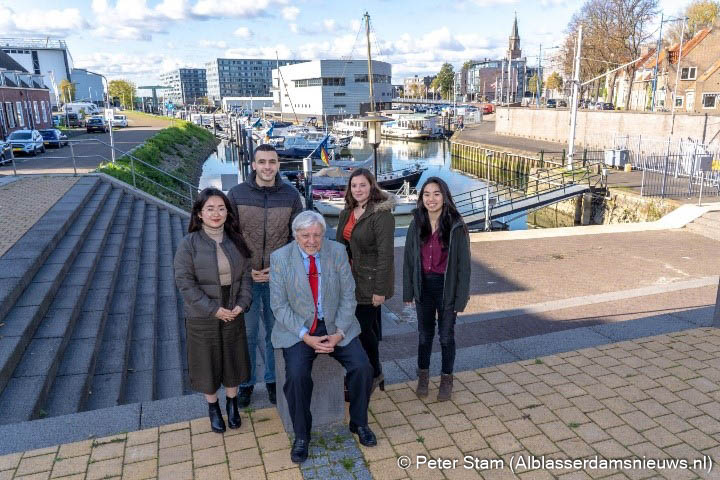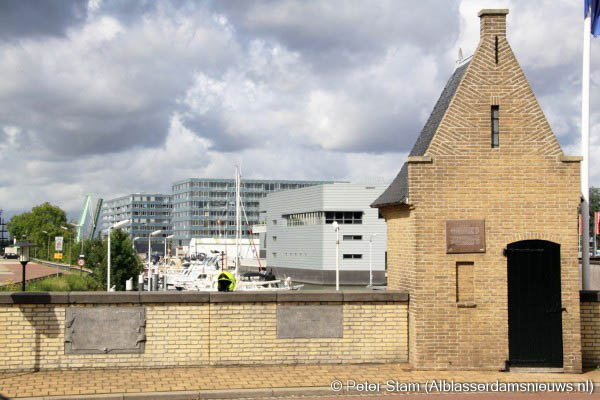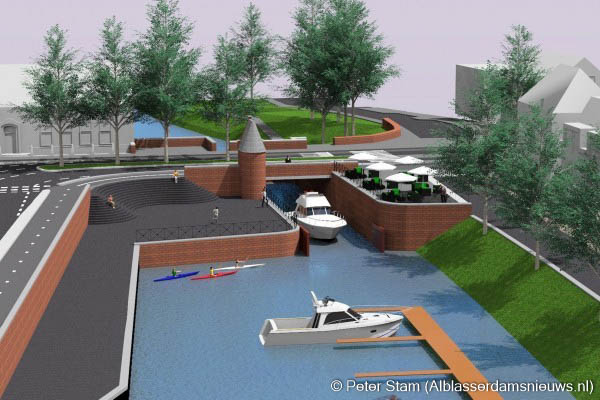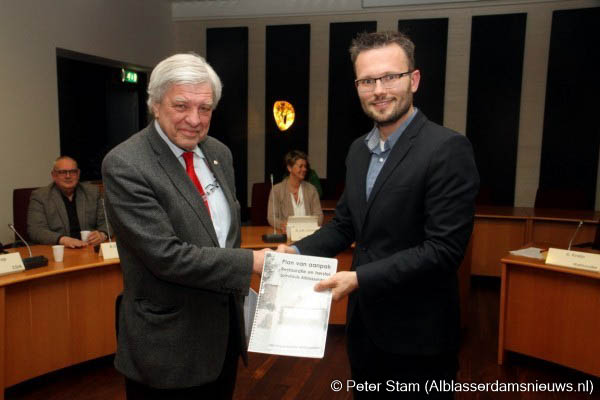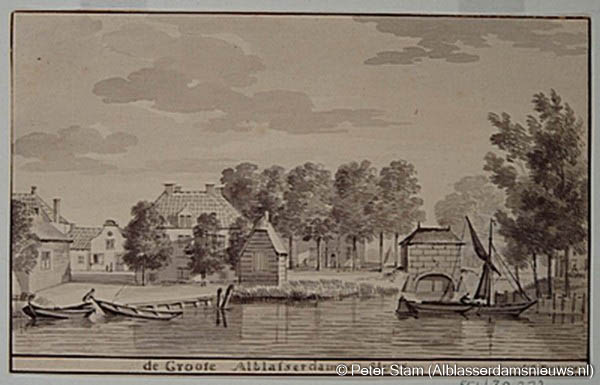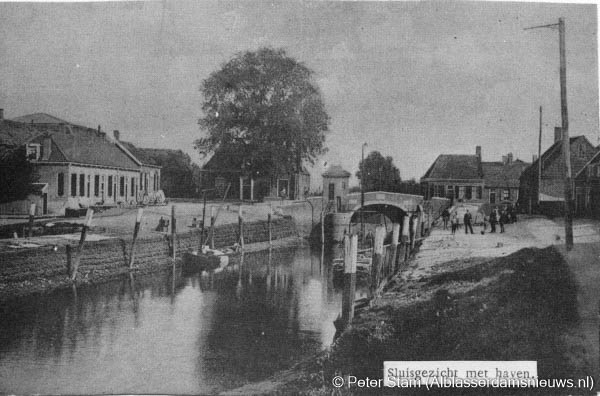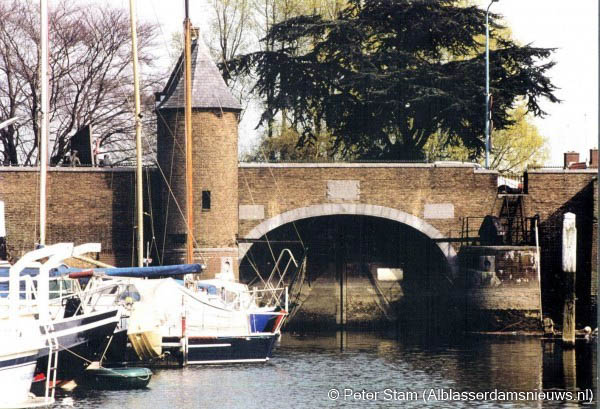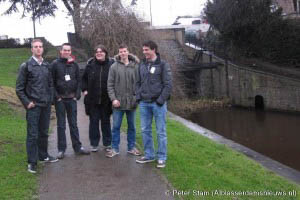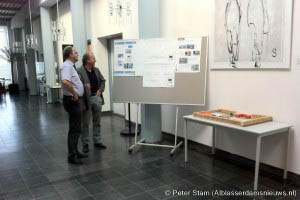Stichting Schutsluis Alblasserdam
LOCK of ALBLASSERDAM
The peat river Alblas flows through Alblasserdam, in the past through the main lock to the river Noord in the center of the village. The reconstruction of this lock and reinstatement of the ecological connection, the transferability and the historical characteristic monument in the village, have been the reason for the Foundation Lock Alblasserdam (Stichting Schutsluis Alblasserdam) to conduct extensive research to the feasibility on the basis of a social cost-benefit analysis.
The embankment and the river basin of the Alblas and the Noord near Alblasserdam bring stories of Zuid-Holland of water together. Of floods and dike reinforcements, of bosoms, mills and pumping stations, of shipbuilders, professional and pleasure boating and dredgers. The area shows the border land-water that shifts over time, the development of the water system of the Middle Ages, around 1277 by an agreement with Count Floris V settled up till now and the specific economic opportunities, to this day of today connected to the river banks.
The lock in Alblasserdam is part of this cultural heritage. It is important that the plans are feasible in both technical, financial and policy terms and can count on a large support in Alblasserdam and Molenlanden. This article will take you shortly along, the underlying reports are of course available on request.
MOTIVE AND HISTORY
The old lock in Alblasserdam has an eventful history of the origin of the village, through floods and natural violence to the derogation of the lock function in 1993.
By filling the lock with sand, an unique piece of Alblasserdam has been lost. For various reasons, an undesirable situation has arisen which the Foundation Lock Alblasserdam wants to redirect as an opportunity for the former lock of the location that connects to the city centre plan (Forest Rijkee, City Hall Square (Raadhuisplein), Landvast (culture centre) , River Port (Buitenhaven), and HavenZuid, a former foreland with a shipyard). This also creates various matching opportunities for the environment. To elaborate about this opportunity, we look at the area urgency and the policy urgency.
Area urgency The area urgent bottlenecks have to do with technology, environment, water quality, heritage, ecology and water sports and recreation.
-Technical urgency: the lock and its immediate surroundings on the inside are in bad condition and show cracks and subsidence. The later intervention, the greater the risks to the environment with dangerous situations.
- Spatial urgency: The decoration of the Dam with the gauge house and the uncluttered crossing for cyclists requirse a better solution. This also fits in well with the centre vision that looks at the entire traffic and spatial structure.
- Ecological Urgency: The stopping of the water in the Alblas causes dirt to accumulate and the diversity of the fish stocks is severely deteriorating. By applying a lock, the exchange of fish takes place between the Noord and the Alblas, which improves the ecological diversity. The flow that brings the passing also improves water quality.
- Hydrological urgency: The Alblas has lost its function as a water way, which prevents the maintenance and dredging work from being carried out. Our goal is to appoint the Alblas / Graafstroom peat stream, the low bosoms of the Nederwaard and the Overwaard as water ways and connect the Noord and via the Dam Lock and Peulen Lock in Hardinxveld-Giessendam with the lower Merwede (Beneden Merwede).
- Recreational urgency: Restoration of the lock makes it possible to experience the tourist hubs over water, the polder landscape and the Unesco mill complex in Kinderdijk / Elshout.
Policy urgency
At all levels of government, policies are created and implemented with policy objectives to which the rebuilding of the lock can make a positive contribution. Affiliation with the State, Provincial and Municipal policy objectives the proposal makes it feasible to achieve these points.
- State Policy: From among others the Synthesis-document Rijnmond-Drechtsteden 1 , great opportunities for improving spatial quality are described as cities and water boards collaborate as partners. It is important that the planning of measures and finances be brought into line. This offers great opportunities for the rebuilding of the lock, precisely by seeking the cooperation between the municipality and the waterboard.
Water safety is not only a matter of building and maintaining dikes, but also of spatial design. In addition, this spatial design is becoming increasingly important in tackling the problems of heavy rain, drought and heat. To be able to live and work well in the Netherlands now and in the future, we have to change the way we set up our urban area. Bringing back a lock in this location can be a very good example of this policy.
- Provincial Policy: The Province of Zuid-Holland has for the Dutch heritage as a policy that the monumental complexes and ensembles in the hertitage line Water Triangle (Kinderdijk, Biesbosch and Drechtsteden) are linked.
The rebuilding of the lock will contribute to this policy in a positive way by restoring the cultural heritage and improving the accessibility and exploitation of the Kinderdijk World Heritage Site.
- Municipal Policy: The college sets out to keep the facilities available and to create new developments. The integrated centre vision still to be set up is central to this. The rebuilding of the lock and the surrounding traffic situation is an excellent fit for this vision. It is possible, in the new situation, to achieve a better traffic settlement. The municipality of Alblasserdam has indicated in the multiannual programme to strive for the possible reopening of the lock.
- Waterboard Policy: Safe dikes, good water quality and sufficient water storage are the important policy issues for the Waterboard. This is all together with the rebuilding of the lock. The dike ring is reinforced, the quality of the water in the Alblas improved and the drainage capacity is increased.
COOPERATION WITH THE ENVIRONMENT
We cannot work out the plan alone. In recent years, the Foundation Lock Alblasserdam has collaborated with the surrounding area. The core team of the foundation has consulted with many stakeholders, at the administrative level and at local level. We continue to do this at every stage of the project. Only then will we come to a supported solution.
Not just rebuilding the lock stimulates employment. A functioning lock also stimulates the development and functioning of the hotel and catering industry and the viability of the centre of Alblasserdam (Haven Zuid). The project will have a recreational function in the entire Alblasserwaard and contribute to the development of Kinderdijk by allowing visitors to stay longer in the area.
CONTENT OF THE PROPOSAL
Foundation Lock Alblasserdam is committed to a high level of ambition: complete rebuilding and opening up of the modern and safe passable lock. A lock with sluice gates, allowing navigation in and out and flow of water takes place.
To achieve these objectives, movable sluice-gate doors are essential. The lock is located in a primary flood defence. As a result, it is imperative that the Province Zuid Holland, the Waterboard Riverland, agrees with the lock.
In consultation with the Province and the Waterboard, the Foundation Lock Alblasserdam wants to work out the new sluice under the following conditions:
1. The lock shall be designed and constructed in such a way as that it to complies with all applicable legislation in this area. (This implies that there are two sets of high-water doors and that facilities are applied to prevent torment (kwel) under and/or along the construction.)
2. All high-water facilities must be automated and can be remotely monitored and controlled by the Waterboard Riverland.
3. The lock is low maintenance built including 30 years maintenance.
In the figure below, the plan for the high level of ambition has been worked out with the specific elements that make this plan so special. This is only one of the possible solutions. It is also possible to situate the lock on the east side so that the height of the passage at the Dam is independent of the tide on the Noord.
Although the lock is a small dot on the map, it has a considerable sphere of influence that extends far beyond the municipality boundaries. Although the costs of the restoration, management and maintenance of the lock are considerable and the direct proceeds from exploitation will be minimal, various parties (governments and agencies, companies and private individuals) may be designated that benefit from a completely rebuilt and reopened lock.
FINANCIAL SUBSTANTIATION
We would like to show by means of a global business case that the potential benefits of the project will be many times greater than the costs.
Costs
From the costs we consider direct, indirect and operating expenses.
- Direct costs: The construction costs were estimated at € 4.7 million in 2012. The estimate was carried out by students of the Hogeschool Rotterdam, supervised by a consultant of Royal Haskoning DHV. This amount is based on a design with the lock near the original location.
- Indirect costs: ' Indirect costs ' means the plan costs (for research, design, administrative costs, external advice, project management, communication, tendering, etc.). Much depends on the choice to incorporate this project into the Centre Vision established by the municipality for the core of Alblasserdam. If this is the case, this project will be part of the official and administrative project organisation as a matching opportunity and the plan costs will be distributed. If the project remains in its own way, we must take account of significant planning costs. These can reach multiple tonnes of Euro.
- Operating costs: By low maintenance building the lock and the 30 years additional maintenance period we guarantee the operating costs in the contract.
Revenue
The proceeds or benefits of the rebuilt lock can also be split into direct and indirect revenues. Although the benefits are not easily quantified, they are significant. The parties that, according to our current insights, will benefit most from the project (globally in decreasing order of interest):
- The municipality of Alblasserdam: increase income from tourist tax, improvement safety crossing Dam / Haven, stool traffic over the dikes, increase feasibility transferium Haven Zuid, increase value real estate along the Alblas and Graafstroom, stronger positioning in the region with a beautiful and lively centre.
- The World Heritage Site Kinderdijk: Increased accessibility over water, possibility to offer complete tourist-recreational product.
- The Wateboard Riverland: Strong improvement water quantity and quality of the Alblas, more possibilities for application ' land to water '.
- The region Drechtsteden: Improving transport by water, more opportunities for tourism and recreation for Alblasserdam and World Heritage Kinderdijk.
- The province Zuid-Holland: Strengthening heritage line Water Triangle, improving transport by water, more opportunities for achieving provincial ambitions.
- Watersports Associations: Increasing possibilities for water recreation, sailing routes through and around the Noord and the Alblasserwaard with connection to Biesbosch.
- Local and regional museums and tourist attractions: Accessible by water, new opportunities for catering and recreational activities along the waterways, increased possibilities for regional arrangements.
- Nature and environmental organisations: Improvement of water quality, strengthening ecosystem (return of certain fish and species), possible energy extraction by flowing water.
- Local and regional business: Centre of Alblasserdam becomes more attractive for horeca, activities in and around the port, opportunities for new forms of transport over water, turnover and employment through work on the lock and the waterways.
- Inhabitants of Alblasserdam (in particular along the Alblas, Graafstroom and Giessen): increase in value of real estate, significant expansion of the sailing area and sailing opportunities.
Conclusion
With the rebuilding of the old lock of Alblasserdam 2, the age-old connection between the outside water (Noord) and the inland waterway (Alblas) is restored. The high level of ambition of the Foundation Lock Alblasserdam (Stichting Schutsluis Alblasserdam) and the elaboration of the plans lead to a positive stimulus for the environment and all environmental parties. Successful rebuilding of the lock has a positive impact on the intended reinforcement and refurbishment of the centre of Alblasserdam 3, the development of the World Heritage Site Kinderdijk, various recreational sailing routes, the ecosystem in the Alblasserwaard and the strengthening of the tourist potential of the Drechtsteden as a whole. Restores a piece of Dutch cultural history!



